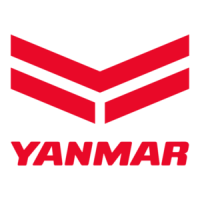BEFORE YOU OPERATE
GM Series Operation Manual 29
12/05
To fill the fuel tank:
Fire and Explosion Hazard.
Operate bilge ventilation (blowers) for a
minimum of 5 minutes to purge fumes
from engine compartment after
refueling. Never operate bilge blower
while refueling. Doing so can pump
explosive fumes into the engine
compartment and result in an
explosion.
1. Clean the area around the fuel cap.
2. Remove the fuel cap from the fuel tank.
3. Fill the tank with clean fuel free of oil
and dirt.
Fire and Explosion Hazard.
Hold the hose nozzle firmly against
the filler port while filling. This
prevents static electricity buildup
which could cause sparks and ignite
fuel vapors.
4. Stop fueling when the gauge shows the
fuel tank is full.
Fire and Explosion Hazard.
Never overfill the fuel tank.
5. Replace the fuel cap and hand-tighten.
Over-tightening the fuel cap will
damage it.
ENGINE OIL
Engine Oil Specifications
Only use the engine oil specified. Other
engine oils may affect warranty coverage,
cause internal engine components to seize
and / or shorten engine life. Never mix
different types of engine oil. This may
adversely affect the lubricating properties
of the engine oil.
Use an engine oil that meets or exceeds
the following guidelines and classifications:
• API Service Categories: CC or higher
TBN value: 9 or more
The oil must be changed when the Total
Base Number (TBN) has been reduced
to 2.0.
TBN (mgKOH/g) test method: JIS
K-2501–5.2–2(HCI), ASTM D4739(HCI)
• Recommended SAE Viscosity: 10W30,
15W40. Engine oil 10W30 and 15W40
can be used throughout the year.
• Never use API Service Category CG-4
or CH-4 oils.
• Be sure the engine oil, engine oil storage
containers and engine oil filling
equipment are free of sediment or water.
• Change the engine oil after the first 50
hours of operation and then at every 150
hours thereafter. See Changing the
Engine Oil on page 54.
GM_OM.book 29 ページ 2013年6月10日 月曜日 午後2時26分

